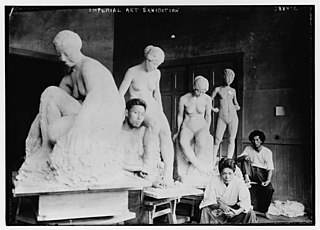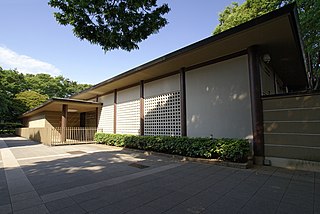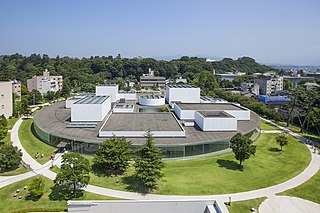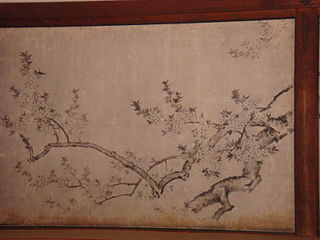Nakaji Yasui was one of the most prominent photographers in the first half of the 20th century in Japan.

Toko Shinoda was a Japanese artist. Shinoda is best known for her abstract sumi ink paintings and prints. Shinoda’s oeuvre was predominantly executed using the traditional means and media of East Asian calligraphy, but her resulting abstract ink paintings and prints express a nuanced visual affinity with the bold black brushstrokes of mid-century Abstract Expressionism. In the postwar New York art world, Shinoda’s works were exhibited at the prominent art galleries including the Bertha Schaefer Gallery and the Betty Parsons Gallery. Shinoda remained active all her life and in 2013, she was honored with a touring retrospective exhibition at four venues in Gifu Prefecture to celebrate her 100th birthday. Shinoda has had solo exhibitions at the Seibu Museum at Art, Tokyo in 1989, the Museum of Fine Arts, Gifu in 1992, the Singapore Art Museum in 1996, the Hara Museum of Contemporary Art in 2003, the Sogo Museum of Art in 2021, the Tokyo Opera City Art Gallery in 2022, and among many others. Shinoda's works are in the collection of the Albright-Knox Art Gallery, the Art Institute of Chicago, the British Museum, the Brooklyn Museum, the Harvard Art Museums, the Metropolitan Museum of Art, the Museum of Fine Arts, Boston, the National Museum of Modern Art, Tokyo, the Singapore Art Museum, the Smithsonian Institution, the Solomon R. Guggenheim Museum, the National Gallery of Victoria, and other leading museums of the world. Shinoda was also a prolific writer published more than 20 books.

The Japan Fine Arts Exhibition is a Japanese art exhibition established in 1907. The exhibition consists of five art faculties: Japanese Style and Western Style Painting, Sculpture, Craft as Art, and Sho (calligraphy). During each exhibition, works of the great masters are shown alongside works of new but talented artists. It claims to be the largest combined art exhibition of its kind in the world and the most popular in Japan.

The Hiroshima City Museum of Contemporary Art is an art museum founded in 1989. It is in Hijiyama Park in Hiroshima, Japan. The building was designed by architect Kisho Kurokawa. It was the first public contemporary art museum to open in Japan, and its exhibitions focus on post-1945, contemporary emerging artists and artworks that link contemporary art with Hiroshima.

The Hyōgo Prefectural Museum of Art is a purpose built municipal art gallery in Nada-ku, Kobe, Hyōgo Prefecture, Japan. It was opened in 2002.

Kenzo Okada was a Japanese-born American painter and the first Japanese-American artist working in the Abstract Expressionist style to receive international acclaim. At the 29th Venice Biennale in 1958, Okada’s work was exhibited in the Japan Pavilion and he won the Astorre Meyer Prize and UNESCO Prize.

Japan Art Academy is the highest-ranking official artistic organization in Japan. It is established as an extraordinary organ of the Japanese Agency for Cultural Affairs in the thirty-first article of the law establishing the Ministry of Education, Culture, Sports, Science and Technology. The Academy discusses art-related issues, advises the Minister of Education, Culture, Sports, Science and Technology on art-related issues, and promotes arts in three categories: 1) fine art, 2) literary arts, 3) music, drama, and dance. It is closely associated with the annual Japan Art Academy Exhibition (Nitten), the premier art exhibition in Japan; the Japan Art Academy originally ran the Nitten but since 1958 the exhibition is run by a separate private institution. The Japan Art Academy headquarters is in Ueno Park, Tokyo.
Ei-Q was a Japanese artist who worked in a variety of media, including photography and engraving.

The 21st Century Museum of Contemporary Art, Kanazawa is a museum of contemporary art located in Kanazawa, Ishikawa, Japan. The museum was designed by Japanese architects Kazuyo Sejima and Ryue Nishizawa of the architectural office SANAA in 2004. In October 2005, one year after its opening, the Museum marked 1,570,000 visitors. In 2020, due to the COVID-19 pandemic it attracted only 971,256 visitors, a drop of 63 percent from 2019, but it still ranked tenth on the list of most-visited art museums in the world.
Minoru Kawabata was a Japanese artist. Kawabata is best known for his color field paintings. Between 1960 and 1981, Kawabata had 11 solo shows at the prominent Betty Parsons Gallery in New York. At the 31st Venice Biennale in 1962, Kawabata’s work was exhibited in the Japan Pavilion alongside that of four other Japanese artists. Kawabata has had solo exhibitions at the Everson Museum of Art in 1974, the Museum of Modern Art, Kamakura in 1975, the National Museum of Modern Art, Kyoto and Ohara Museum of Art in 1992, and Yokosuka Museum of Art in 2011. Kawabata’s works are in the collection of the Albright-Knox Art Gallery, Artizon Museum, Everson Museum of Art, Museum of Contemporary Art Tokyo, the Museum of Modern Art, Kamakura & Hayama, the Museum of Modern Art, São Paulo, the National Museum of Art, Osaka, the National Museum of Modern Art, Kyoto, the National Museum of Modern Art, Tokyo, the Newark Museum of Art, Ohara Museum of Art, Solomon R. Guggenheim Museum, Yokohama Museum of Art, Yokosuka Museum of Art, among others.

The Nihon Bijutsu Tōken Hozon Kyōkai is a public interest incorporated foundation established in February 1948 to preserve and promote Japanese swords that have artistic value. They run a Japanese Sword Museum in Tokyo and have a secretariat in the building.

The Hara School was a Kyoto-based Japanese painting atelier established in the late Edo era, which continued as a family-controlled enterprise through the early 20th century. The Hara artists were imperial court painters and exerted great influence within Kyoto art circles. They contributed paintings to various temples and shrines, as well as to the Kyoto Imperial Palace.

The Museum of Modern Art, Ibaraki opened on the shore of Lake Senba in Mito, Ibaraki Prefecture, Japan, in October 1988. The collection, numbering some 3,700 pieces as of October 2015, includes works by Manet, Monet, and Renoir, Gustave Courbet, Eugène Carrière, Camille Pissarro und Alfred Sisley as well as Yōga and Nihonga by artists including Tsuguharu Foujita, Heihachirō Fukuda, Taikan Yokoyama, Yukihiko Yasuda, Tetsugoro Yorozu, Kanzan Shimomura, Kenzo Okada, Yasuo Kuniyoshi, Kiyokata Kaburagi, Kokei Kobayashi, Gyoshū Hayami, Hishida Shunsō, and Shikō Imamura.

Otake Chikuha was a Japanese painter. He was first known for his nihonga and ukiyo-e paintings. Although he was a praised figure at the height of his career, he later lost his reputation. He moved onto experimenting with more ambitious styles motivated by his anti-mainstream sentiments.
Hideko Fukushima, born Aiko Fukushima, was a Japanese avant-garde painter born in the Nogizaka neighborhood of Tokyo. She was known as both a founding member of the Tokyo-based postwar avant-garde artist collective Jikken Kōbō and was recruited into Art Informel circles by the critic Michel Tapié during his 1957 trip to Japan. As a member of Jikken Kōbō she participated in art exhibitions, designed visuals for slide shows and costumes and set pieces for dances, theatrical performances, and recitals. She contributed to the postwar push that challenged both the boundaries between media and the nature of artistic collaboration, culminating in the intermedia experiments of Expo '70.
Kazuo Yagi was a Japanese potter and ceramic artist best known for spearheading the introduction of nonfunctional ceramic vessels to the Japanese pottery world. With an innovative ceramicist as his father, Yagi was sent to art school to study sculpture, instead of pottery. After graduating in 1937, he continued to train in the progressive circles, such as the National Ceramic Research Institute and the Japan Ceramic Sculpture Association. Following a short period of military service in 1939 and through the early postwar years, he was involved in a series of collectives that sought to transcend the traditional aesthetic values in not just ceramics but also in a range of visual media.

The Wajima Museum of Urushi Art is a museum located in Wajima, Japan. The museum specializes in lacquer art.
Kinuko Emi was a Japanese painter. Emi is best known for her abstract painting in bold colors featuring the motif of four classical elements. At the 31st Venice Biennale in 1962, Emi's work was exhibited in the Japan Pavilion alongside that of four male artists, making her the first Japanese woman artist to be shown at the country's Pavilion. She had retrospective exhibitions at the Yokohama Civic Art Gallery in 1996, the Museum of Modern Art, Kamakura in 2004 and Himeji City Museum of Art in 2010. Emi's works are in the collection of the National Museum of Art, Osaka, the Museum of Contemporary Art Tokyo, the Museum of Modern Art, Kamakura & Hayama, Yokohama Museum of Art, and Takamatsu Art Museum, among others. Emi's daughter, Anna Ogino, is an Akutagawa Prize-winning novelist and emeritus professor of French literature at Keio University, Tokyo, who serves as the custodian of her mother's works and legacy.
Toeko Tatsuno was a Japanese abstract painter, printmaker, and former professor at Tama Art University in Japan.
Michael Rikio Ming Hee Ho is an American conceptual artist. Ho was born in Hilo, Hawaii and grew up in Waimea, Hawaii County, Hawaii. He graduated from UCLA School of the Arts and Architecture in 2018 and lives and works in Tokyo, Japan.

















